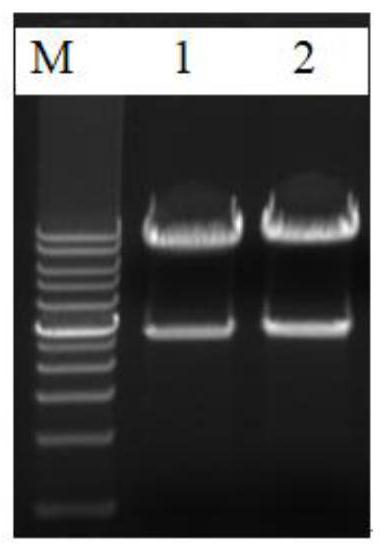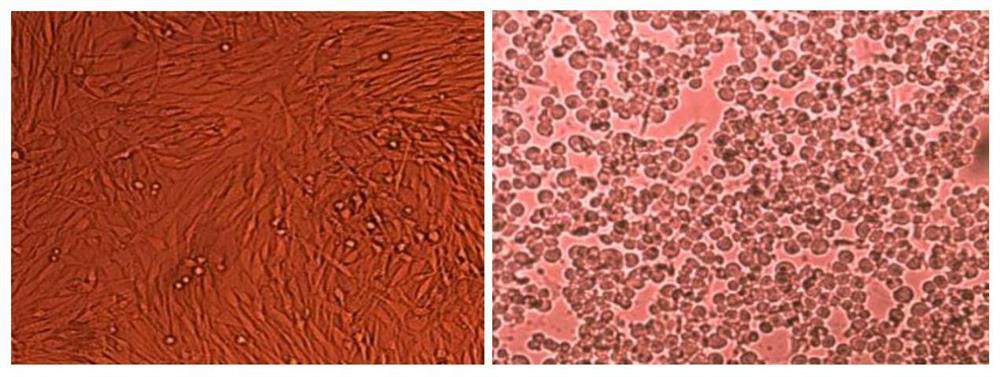Foot-and-mouth disease O-type PanAsia-2 pedigree reserve vaccine strain as well as construction method and application thereof
A technology of foot-and-mouth disease vaccine and construction method, which is applied in the field of foot-and-mouth disease O-type PanAsia-2 pedigree reserve vaccine strain and its construction, which can solve the problems that the recombinant virus cannot be successfully rescued and affects the virus replication ability, etc.
- Summary
- Abstract
- Description
- Claims
- Application Information
AI Technical Summary
Problems solved by technology
Method used
Image
Examples
Embodiment 1
[0061] Construction method of FMDV recombination full length cloning
[0062] PSK-Z123 in FMDV O / HN / CHA / 93 vaccine strains (this plasmid is open in article Evaluation of Agenetical Modified Foot-Mouth Disease Virus Vacine Candidate GeneratedBy Reverse Genetics, Li et al.bmc Verinary Research 2012 8: 57) For the skeleton, it is designed to synthesize plasmids PSK-Z123 / Tur09VP1 containing FMDV O / Tur / 5 / 2009 strain VP1 gene. The above recombinant plasmids were digested with SPE I and BGLII, respectively, and the target belt of approximately 5400 bp was recovered, and the plasmid of digestible plasmid was inserted with the same enzyme (the plasmid Evaluation of a genetically modified foot-mouthdisease Vircine Candidate generated). By Reverse Genetics Open, Li ETAL.BMC Veterinary Research 2012, 8: 57), is obtained, and yang-type POFS-TUR09 / VP1 is obtained. Structure of the whole genome structure of FMDV full length recombinant plasmid figure 1 .
[0063] The recombinant pl...
Embodiment 2
[0066] Rescue of restructuring of viruses
[0067] Using NOT I enzyme linear plasmid POFS-TUR09 / VP1, then purified as a transfection template with a DNA fragment recovery kit. Conventional cultured single-layer BSR / T7 cells grow to 70% to 80%, liposome Lipofectamine TM 2000 mediated transfection (see the operating manual). Fully medium was added 5 hours after transfection, and 37 ° C 5% CO was placed. 2 The incubator continues to cultivate, and the transfection of cells have caused cytoplasions daily. After the transfection of 72h, the cells were harvested, and after repeatedly frozen 2 to 3 times, it was continuously passed in BHK21, and the various viruses were stored at -70 ° C.
[0068] The results showed that the linear plasmid POFS-TUR09 / VP1 transfected with BSR / T7 cells for 70 hours, the cells showed a typical cell lesion, that is, the cells became large, the circle, and became the distribution of grapes (see image 3 And the control cell morphology is intact and is ...
Embodiment 3
[0070] Identification of recombinant viruses
[0071] 3.1, indirect immunofluorescence
[0072] The collected transfection supernatant and parent virus RHN growth growth to 70% to 80% of the full single-layer BHK-21 cells, incubated for 6 h, rinsed with PBS buffer 3 times, 3.7% polyformaldehyde room temperature fixed 20 min, PBS buffer Wash 3 times, 50 mmol / L ammonium chloride, thermostat 10min, PBS buffer washing 3 times, add anti-FMDV non-structural protein 3a, a monoclonal antibody 3A24 (3A24 in the literature "foot-and-mouth disease, non-structural protein 3A monoclonal antibody And Identification, China Veterinary Science 2010, 40 (04): 331-336 is disclosed) 37 ° C for 1 h, PBS rinsing 3 times, then add FITC-labeled goat anti-mouse antibody 37 ° C for 1 h, PBS rinsing After 3 times, 0.5 μg / ml DAPI (PBS preparation) was added to 10 minutes, and PBS washed three times, and the excess DAPI was removed, and the photo was placed under the coke fluorescence microscope.
[0073]...
PUM
 Login to View More
Login to View More Abstract
Description
Claims
Application Information
 Login to View More
Login to View More - R&D
- Intellectual Property
- Life Sciences
- Materials
- Tech Scout
- Unparalleled Data Quality
- Higher Quality Content
- 60% Fewer Hallucinations
Browse by: Latest US Patents, China's latest patents, Technical Efficacy Thesaurus, Application Domain, Technology Topic, Popular Technical Reports.
© 2025 PatSnap. All rights reserved.Legal|Privacy policy|Modern Slavery Act Transparency Statement|Sitemap|About US| Contact US: help@patsnap.com



